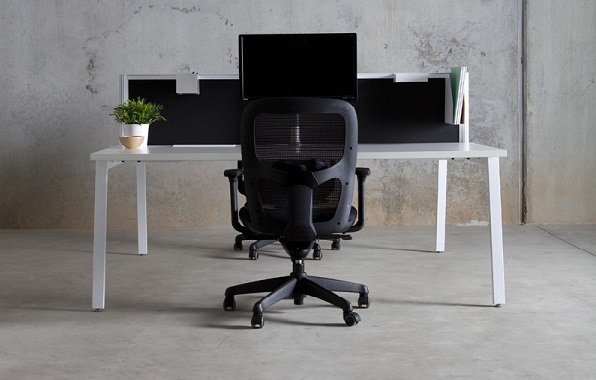
Most office staff spend a good portion of their waking hours sitting at a desk or working at a computer. Take the right steps to create an ergonomic workplace, and make your business buzz through increased productivity.
Tips for an Ergonomic Workplace
Your work area
- make sure your work area is large enough that you are comfortable
- check that it allows for a full range of motion
- make room for the items you use most often
- ensure you do not have to strain to reach the items you use most often
Your work habits
- think about your work habits and ensure you are not putting unnecessary stress on your body
- change positions frequently so repetitive tasks do not wear you out
Your desk
- make sure you have the right type of desk for the work you perform (size and shape)
- keep your desk uncluttered—on top and underneath (ensure nothing interferes with your ability to sit properly)
Your chair
- push hips as far back as they can go in your chair
- adjust seat height so feet are flat on the floor and knees are equal to, or slightly lower than, your hips (use a footrest if your feet dangle)
- adjust armrests (if fitted) so your shoulders are relaxed
- if armrests are in the way, remove them
- make sure your lower back is supported (adjust lumbar support)
- do not maintain any one posture for more than an hour
- finetune your chair every so often
Your keyboard
- select the correct size and shape of keyboard for the type of work you do (many ergonomic styles are available)
- pull up close to your keyboard
- position keyboard directly in front of your body
- adjust keyboard so the section you use most frequently is centred with your body
- adjust keyboard height so your shoulders are relaxed, elbows are in a slightly open position and your wrists and hands are straight
Your mouse
- select the correct size and shape mouse for the size of your hand (many ergonomic styles are available)
- make sure your mouse is within easy reach
- do not grip it too tightly
- if the mouse bothers you, try another type of device such as a trackball or a touch pad
- alternate hands when using your mouse (takes some time to get used to, but worth it)
Your typing habits
- keep your wrists elevated
- avoid hitting the keys too hard
Your monitor/screen
- adjust your monitor/screen so it is directly in front of you, in line with your keyboard
- adjust it so your neck is in a neutral, relaxed position
- position the top of the monitor so it is approximately two to three inches above your eye level when seated (if you wear bifocals, lower the monitor to a comfortable reading level)
- sit at least an arm’s length away from your screen
- reduce glare by positioning your monitor well—at right angles to windows, out of direct sunlight etc.
- adjust curtains or blinds as needed
- adjust screen controls to minimise glare from overhead lights
- use optical glass glare filters, light filters or secondary task lights to reduce glare
Your documents
- position documents directly in front of you, between the monitor and keyboard
- if insufficient space, place documents in a document holder positioned adjacent to the monitor
Your laptop
- it is best to use your laptop on a table, not on your lap
- if you use it frequently or for long periods it is best to use a separate keyboard and a mouse, rather than the in-built keyboard and mouse Your telephone
- place within easy reach
- use headsets and/or speaker phone so you don’t have to cradle the phone receiver between your neck and shoulder
- avoid multitasking when on the phone
Eye fatigue
- rest and refocus your eyes periodically by looking away from the computer monitor and focusing on something in the distance
- rest your eyes periodically by covering them with your palms for between 10 and 15 seconds Take breaks
- take short breaks (1 to 2 minutes) every 20 to 30 minutes
- after each hour at work, take a break or change tasks for between 5 and 10 minutes
- leave your computer during lunch
Take breaks
- take short breaks (1 to 2 minutes) every 20 to 30 minutes
- after each hour at work, take a break or change tasks for between 5 and 10 minutes
- leave your computer during lunch

